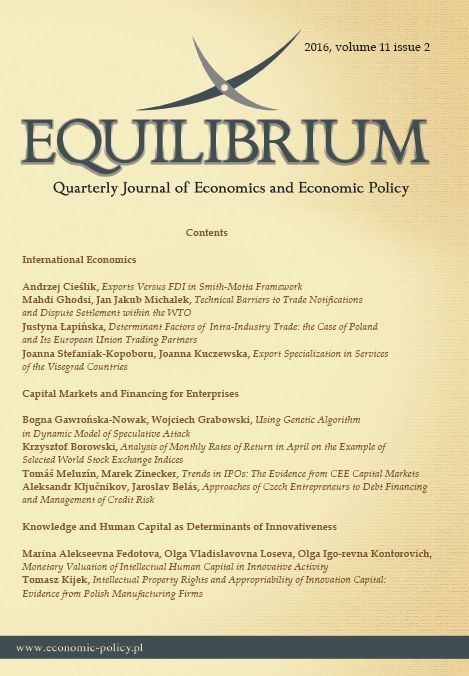Export specialization in services of the Visegrad countries
DOI:
https://doi.org/10.12775/EQUIL.2016.012Keywords:
international trade, services, specialization, comparative advantage, Visegrad countriesAbstract
The importance of services and the international trade in services is growing systematically. There are some reasons for that, especially the rapid development of IT technologies. This increase in the international trade in services is a global phenomenon, however there are some other specific issues, other than economic or technological, which might influence the trade in services in particular countries. As for the countries of the Central and Eastern Europe such a factor could be the accession to the European Union (EU). The objective of the paper is to analyse the export specialization of the Visegrad countries in the international trade in services and how it changed over seven years after the EU accession. The service sector comprises of a variety of highly heterogeneous economic activities and the diversity of services is also reflected in the international trade of particular countries. Generally, the trade theories deal with trade of goods, but there are some attempts already to apply these theories for services. To find out the export specialization based on the comparative advantage in particular services, the main categories of services are analysed based on the adjusted RCA index assumptions. The analysis prepared in the paper is based on the balance of payment statistics provided by the WTO. The article is concluded by discussing the questions about the export specialization of particular countries and how it changed after the accession to the EU.
Downloads
References
Dalum, B., Laursen, K. & Villumsen, G. (1998). Structural Change in OECD Export Specialisation Patterns: De-specialisation and ?Stickiness?. International Review of Applied Economics, 12(3). DOI: http://dx.doi.org/10.1080/026921 79800000017.
Daniels, P. W. (1993). Service Industries in the World Economy. Oxford: Blackwell.
Deardorff, A. V. (1985). Comparative Advantage and International Trade and Investment in Services. Research Seminar in International Economics, Gerald R. Ford School of Public Policy, The University of Michigan, Post-Print Paper, 5.
Donges, J. B., & Riedel, J. (1977). The Expansion of Manufactured Exports in Developing Countries: An Empirical Assessment of Supply and Demand Issues. Weltwirtschaftliches Archiv, 113(1).
Feketekuty, G. (1988). International Trade in Services: An Overview and Blueprint for Negotiations. Cambridge Massachusets: Bullinger Pub Co.
Francois, J., & Hoekman, B. (2010). Services Trade and Policy. Journal of Economic Literature, 48(3). DOI: http://dx.doi.org/10.1257/jel.48.3.642.
Grunfeld L., Moxnes A. (2003). The Intangible Globalization: Explaining the Patterns of International Trade in Services. Norwegian Institute of International Affairs, Working Paper, 657.
Hindley, B., & Smith, A. (1984). Comparative Advantage and Trade in Services. World Economy, 7(4). DOI: http://dx.doi.org/10.1111/j.1467-9701.1984. tb00071.x.
Kuźnar, A. (2007). International Trade in Services in Developing Countries ? Threats and Opportunities. Are Developing Counties Competitive? European Trade Study Group (ETSG), 2007 papers, Retrieved from http://www.etsg.org/ ETSG2007 /papers/kuznar.pdf (30.05.2013).
Langhammer, R. J. (2004). Revealed Comparative Advantages in the Services Trade of the United States, the European Union and Japan: What Do They Tell us?. Journal of World Investment & Trade, 5(6).
Laursen, K. (1998). Revealed Comparative Advantage and the Alternatives as Measure of International Specialization, Danish Research Unit for Industrial Dynamics, DRUID Working Paper, No. 98?30.
Lee, J. (2010). Export Specialization and Economic Growth Around the World. Economic Systems, 35(1). DOI: http://dx.doi.org/j.ecosys.2010.11.002.
Lennon, C. (2009). Trade in Services and Trade in Goods: Differences and Complementarities, WIIW Working Papers, no. 53, April 2009.
Liesner, H. H. (1958). The European Common Market and British Industry, Economic Journal, 68. DOI: http://dx.doi.org/10.2307/2227597.
Markusen J., Rutherford T. & Tarr D. (2005). Trade and Direct Investment in Producer Services and the Domestic Market for Expertise. Canadian Journal of Economics, 38(3). DOI: http://dx.doi.org/10.1111/j.0008-4085.2005.00301.x.
Mongiało, D. (2007). Specjalizacja eksportowa krajów UE w międzynarodowym handlu usługami. Studia Europejskie, 3.
Prieto, F. (1989). Trade in Services: Some Comments on Comparative Advantage. Services Development: The Role of Foreign Direct Investment and Trade. United Nations.
Proudman, J., & Redding, S. (2000). Evolving Patterns of International Trade. Review of International Economics, 8. DOI: http://dx.doi.org/10.1111/1467-9396.00229.
Snape R. H. (1990). Principles in Trade in Services. In P. Messerlin & K. P. Sauvant (Eds.). The Urugway Round. Services in the world economy. Washington, D.C: The World Bank, United Nations Centre on Transnational Corporation.
Stern, R. M. & Hoekman, B. M. (1987). Issues and Data Needs for GATT Negotiations on Services. World Economy, 10(1).
Vollrath, T. L. (1991). A Theoretical Evaluation of Alternative Trade Intensity Measures of Revealed Comparative Advantage. Weltwirtschaftliches Archiv, 127(2).
Wróbel A. (2009). Międzynarodowa wymiana usług. Warszawa: Wydawnictwo Naukowe Scholar.
WTO (2013). WTO Statistical Data Sets ? Metadata, Retrieved form http://stat.wto.org/StatisticalProgram/WSDBStatProgramTechNotes.aspx?Language=E#Def_Meth_Services.
Yeats, A. J. (1985). On the Appropriate Interpretation of Revealed Comparative Advantage Index: Implications of a Methodology Based on Industry Sector Analysis. Weltwirtschaftliches Archiv, 121.






